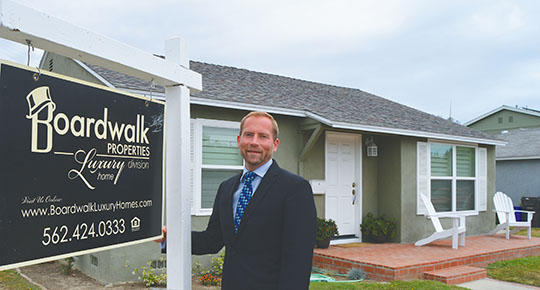An extreme lack of inventory of single-family homes for sale in Long Beach, coupled with high demand for entry-level and mid-priced properties, is resulting in bidding wars and is driving up sales prices, according to local real estate agents. Meanwhile, high-end homes are selling at a slower rate. Professionals interviewed by the Business Journal said they expect these trends to continue at least throughout 2016.
“The biggest problem we’re having right now is that there is no inventory,” Mary Ann Edwards, office manager and agent with Re/Max College Park Realty, told the Business Journal. “And the number of buyers hasn’t decreased.”
Geoff McIntosh, president-elect of the California Association of Realtors and owner of Long Beach’s Main Street Realtors, estimated that the current inventory of single-family homes in Long Beach is about 1.8 months. In other words, it would only take about 1.8 months for all listed homes in Long Beach to sell. The historical long-run average is about 6 months of inventory.

Justin Potier, broker associate for Boardwalk Properties, said that properties in the Los Altos area, like this one at 2194 San Vicente Ave., are highly desirable among first time homebuyers. The two-bedroom, one bath property is listed for $539,000. (Photograph by the Business Journal’s Larry Duncan)
McIntosh and Edwards both noted that entry-level homes are currently highest in demand. “Anything [priced] under $500,000, it’s gone. It sells fairly quickly,” Edwards said. “We don’t have single family residences [listed] under $450,000 anymore, in any part of the city.” An exception might be small two-bedroom homes in North Long Beach, but three-bedroom homes at that price point simply aren’t around any more, she added.
The median selling price of homes in Long Beach is currently about $586,000, according to McIntosh.
While the Los Altos neighborhood is “really hot” at the moment, McIntosh said that no single neighborhood in Long Beach is outpacing the others in terms of demand. “There is so little inventory that pretty much anything in that start price range is good,” he explained.
“There’s a lack of inventory, and properties that are priced correctly are moving very quickly, typically with multiple offers, and are going over asking price,” Justin Potier, broker associate for Bixby Knolls-based Boardwalk Properties, said. “Homes under $625,000 or $700,000 are flying off the market.”
The dynamic of low supply and high demand continues to drive up sales prices for homes in Long Beach. For example, a two-bedroom, 890-square-foot property in Los Altos that Potier recently listed on the market just went into escrow for $532,500. “It was purchased in September of 2013 for $370,000,” he noted.
“In contrast, if you look at your higher-end market, that one seems to be a little bit slower,” Potier observed. “Homes that are $900,000 and above are sitting longer.”
McIntosh said that, while homes priced above $800,000 aren’t selling as quickly as they were in previous months, the high-end market between $800,000 and $1.4 million is “still pretty robust.” However, the closer homes are to $2 million in price, the longer they sit on the market.
Potier said that higher-end homes are usually purchased by second-time homebuyers moving into more expensive properties. “Typically you’re looking at somebody maybe in an executive position, or a business owner,” he said. “We’re in an election year, so they’re probably waiting to see how that unfolds and how that might impact their business outlook moving into the next four years. Coupled with that, they’re just being a little more discerning and cautious about where they’re spending their money.”
The condominium market is facing similar constraints to the market for single-family detached homes, with about 2.2 months of inventory in Long Beach, according to McIntosh. In March, the median sales price of condos in Long Beach was $312,000, he said.
The low inventory constraint on the market is in part because construction of new residential units has not kept up with demand, McIntosh explained. “In the State of California we have been under building at about 100,000 units per year for more than 10 years, so we have a real housing shortage,” he said. “The problem really is a local government issue more than anything else. Everybody agrees we need more housing; most people just don’t want it in their community because they’re already impacted in various ways.”
Perhaps what’s needed is an attitude shift, McIntosh suggested. “I would hope that as a population, not just in Long Beach but any place, that we would start to reevaluate density and adapt to the new reality, especially in coastal communities, that we need to forgo some of the luxuries that we’ve enjoyed with our large lots and single-family residences and opt for more compact living,” he said. “It’s not only good for real estate values and bringing prices down to a more affordable level, but it’s much better in terms of ecology and the impact on the environment.”
